Displaying items by tag: M2
Raging Bull Top Again in First ISORA Race
A 'tough opener' is how Commodore Peter Ryan has described the first ISORA offshore sailing race of the season from Holyhead to Dun Laoghaire yesterday. Inspite of the difficult conditions though there was little change at the top of the leader board. Skerries domination of Irish Sea racing continues with the Sigma 400 Raging Bull maintaining his winning form. It was a very hard race with usual flukey conditions trying to leave Dublin Bay at 8am on Saturday morning (Afloat.ie followed the fleet out of the bay on twitter). Strong winds followed for the beat to the M2 buoy before another long leg and a short beat to Holyhead. The sea conditions on the 60-mile course were trying for many crew who were out for the first time this season.
ISORA has formed three classes this season, the aim is to give better competitive sailing between similar boats. First race results below.
| Boat Name | Sail No. | Type | IRC Rating | Finish Time | Time elapsed | Corrected | Place | Place |
| (provisional) | Time | Class | O/A | |||||
| English Mick | GBR4771R | Beneteau 47.7 | 1.130 | 19:18:26 | 40706 | 45997 | 2 | 8 |
| GFT Adventurer | GBR23161 | Beneteau 45 | 1.101 | 19:54:46 | 42886 | 47217 | 3 | 9 |
| Quite Correct | IRL 5405 | DS54 | 1.095 | RET | - | - | - | - |
| African Challenge | IRL 2649 | Fast 42 | 1.077 | RET | - | - | - | - |
| Tsunami | IRL 4007 | First 40.7 | 1.061 | 18:48:01 | 38881 | 41252 | 1 | 4 |
| Lancastrian | GBR 7682T | Starlight 14.5m | 1.059 | 20:27:00 | 44820 | 47464 | 4 | 10 |
| Rebellion | IRL 6001 | Nicholson 58 | 1.054 | RET | - | - | - | - |
| Orna | IRL 532 | 1.047 | DNS | - | - | - | - | |
| Madam Wen | GBR1417L | Sweden 42 | 1.04 | RET | - | - | - | - |
| Aztec 3 | IRL29832 | A35 | 1.034 | 18:59:30 | 39570 | 40915 | 3 | 3 |
| Raging Bull | IRL 9666 | Sigma 400 | 1.027 | 18:42:30 | 38550 | 39590 | 1 | 1 |
| Jedi | IRL 8088 | J109 | 1.029 | RET | - | - | - | - |
| Sgrech | GBR9319R | J109 | 1.026 | 19:01:52 | 39712 | 40744 | 2 | 2 |
| Miss Scarlett | IRL 4763 | Sunfast 40.3 | 1.025 | RET | - | - | - | - |
| Lula Belle | IRL 3607 | First 36.7 | 1.019 | 19:35:55 | 41755 | 42548 | 5 | 6 |
| First of September | IRL 8581 | First 43.5 | 1.017 | DNS | - | - | - | - |
| Dinah | IRL 3508 | JOD 35 | 1.016 | 19:36:22 | 41782 | 42450 | 4 | 5 |
| Adelie | FRA 9631 | First 34.7 | 0.988 | 21:26:00 | 48360 | 47779 | 2 | 11 |
| Mojito | GBR 4184 | Bravaria 39 | 0.988 | 20:36:22 | 45382 | 44837 | 1 | 7 |
| Mistral of St Helier | K 8337 | Sigma 38 | 0.984 | RET | - | - | - | - |
| Yahtzee | IRL 1068 | Oceanis 411 | 0.983 | 02:23:00 | 66180 | 65054 | 3 | 12 |
| Obsession | IRL 4513 | Sigma 33 | 0.905 | RET | - | - | - | - |
| Sarnia | IRL 2260 | 0.891 | RET | - | - | - | - |
Overall ISORA Honours will be Determined by September Race
In an exciting sailing climax for a buoyant ISORA series September's race will determine the overall winner. “Raging Bull”, “Just Enough” and the reigning Champion, “Tsunami” can all take the Wolf’s Head Trophy. Peter Ryan reports on this and news from last weekend's race 8, the M2 buoy race.
The series table is available to download below.
From an entry list of 30 boats, 17 boats came to the line in Dun Laoghaire for the 8th ISORA race. We had one new boat taking part in this race, “Oystercatcher”. The course for the night was: Start – M2 Weather Buoy (P) –Finish.
The forecast for the race looked perfect – 10-12 kts South west. It was expected that the fleet would complete the 54-mile course with no problem. However, as usual, this is not what happened!!! While all boats completed the course, the winds were far from perfect.
The race was started by Peter Beamish, Commodore of the Royal Alfred Yacht Club and Paul McCarthy. The wind at the start was 16kts – south west. This gave a dead run to the M2. The fleet started off the line with spinnakers. As the course was a dead run, the fleet broke into two gybes. Twelve boats heading north towards Howth head while five boats heading out towards Kish. All of a sudden a big hole appeared around the five boats and sat closely by for over a hour while the north fleet headed over the horizon. It was not until the north fleet was a dot on the horizon did the wind fill in and the five boats headed off towards M2. The wind had backed making the leg a broad reach. The wind also increased to 23 knots as the fleet approached M2.
“Roller Coaster” was the first to round M2 with the remainder of the fleet following in procession. It seemed like the return leg would be a simple fetch back to Dun Loaghaire. However, the wind was having none of this. There were several massive wind shifts and wind speed variations all through the leg. Shifts in the order of 60 degrees were experienced as the fleet got into Dublin Bay.
“Roller Coaster” took line honours, 1st Overall and 1st in Class 1. “Team Windmill” took 2nd Overall and 2nd Class1. “Raging Bull” took 3rd Class 1. “Big Hillie Style” took 1st Class 2 and 3rd Overall. Newcomer “Oystercatcher” took 2nd in Class 2 while “Just Enough” took 3rd Class 2.
The next race is on the 11th September, the James Eadie Race from Pwllheli to Howth. The Overall ISORA Championship will be determined by the outcome of this race. “Raging Bull”, “Just Enough” and the reigning Champion, “Tsunami” can all take the Wolf’s Head Trophy.































































